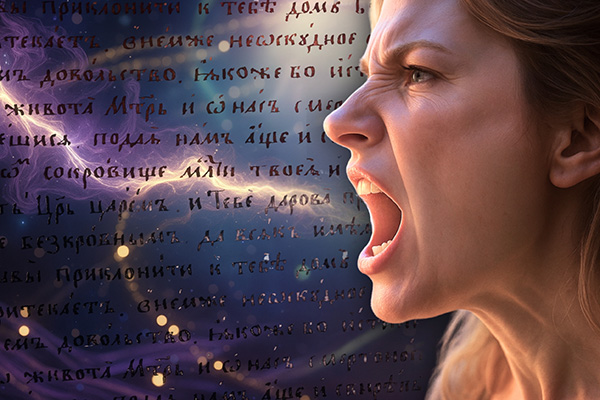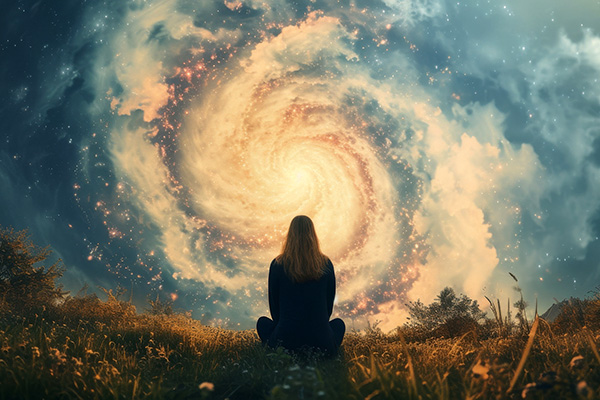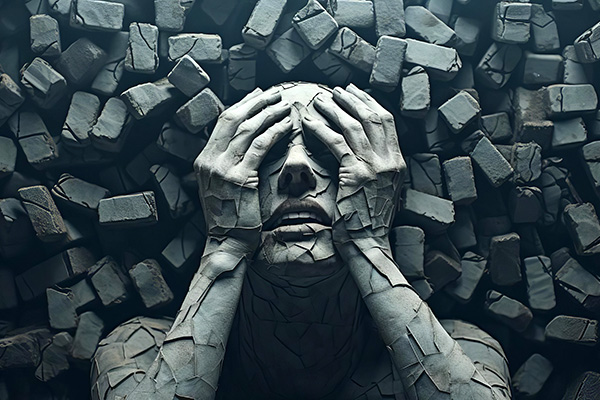bible
The Spiritual Power Of The Words You Speak
 Have you ever stopped to truly consider the words you speak? Most of us talk all day, every day, without realizing the impact of each syllable we send out into the world.
Have you ever stopped to truly consider the words you speak? Most of us talk all day, every day, without realizing the impact of each syllable we send out into the world.
Words are much more than just communication sounds. They’re vibrations, frequencies, and intentions. Whether spoken softly, shouted out loud, or whispered quietly to yourself, every word carries mystical energy.
In many spiritual traditions, the spoken word is seen as a powerful metaphysical force or divine power. It is a force of creation and transformation.
From magical incantations to sacred ceremonies, words have long been used to shape everyday reality, influence the world and improve life.
The earliest recorded reference to the power of speech dates back to ancient Mesopotamia. In the city of Uruk, magical incantations were found carved onto clay tablets dating back to approximately the 5th century BCE. These spoken spells were used for protection, healing, and influencing others, revealing a deep understanding of the energetic and powerful nature of speech as early as 2,500 years ago.
Around the same time, the ancient Egyptians believed in the concept of heka, which is often translated today as “magic” but really means “divine creative power.” They believed the gods used heka to create the world, and that humans could access this same creative power through sacred words called hekau.
Why Psychics, Healers And Empaths Use Essential Oils
 Essential oils have long been sacred allies in spiritual and healing traditions around the world. Extracted from the aromatic essence of plants, these oils carry more than just fragrance; they carry the energetic blueprint and vibrational frequency of their botanical origins.
Essential oils have long been sacred allies in spiritual and healing traditions around the world. Extracted from the aromatic essence of plants, these oils carry more than just fragrance; they carry the energetic blueprint and vibrational frequency of their botanical origins.
In spiritual practice, essential oils are potent tools for emotional alignment, energetic cleansing, and deepening our connection to the self, spirit, and earth, far surpassing their role as mere pleasant scents.
Essential oils act as bridges between the tangible and the intangible. They provide sensory cues that encourage relaxation of the body, focus of the mind, and openness of the spirit. While they don’t replace deep inner work or professional guidance, they provide gentle, supportive energy that enhances existing practices.
The use of essential oils in spiritual practices is anything but modern. Prophets, priests, shamans, and oracles across the ancient world worked with aromatic oils and resins as sacred tools to facilitate divine connection, purification, and inner vision.
In ancient Egypt and the Near East, frankincense and myrrh were revered not just for their fragrance, but for their ability to open spiritual gateways. Frankincense, often referred to as “liquid gold,” was burned in temples and used in rites of passage. Myrrh featured in sacred anointing blends and was considered essential for emotional release and spiritual attunement.
Holding On To What Never Changes
 Nature always inspires deep thoughts in me. There’s something about pausing to watch the wind rustle through the trees or to see the sun gently filter through the clouds that invites stillness and reflection.
Nature always inspires deep thoughts in me. There’s something about pausing to watch the wind rustle through the trees or to see the sun gently filter through the clouds that invites stillness and reflection.
Today, I found myself contemplating the constantly changing seasons. In the Northern Hemisphere, we are a month away from the summer solstice, and the days are becoming increasingly long and warm with golden light. The trees are lush and full, the air hums with the sound of insects, and gardens overflow with life.
Change is everywhere. It’s evident in the ripening of fruit, the intense afternoon heat, and the subtle shift in the season’s energy toward harvest.
It’s not just nature, either. Our lives are constantly evolving, too. Relationships shift, careers transition, health fluctuates, and dreams reshape themselves over time.
No matter where we turn, we hear messages such as “Change is inevitable,” and “Don’t be afraid of change.”
Yes, change is necessary. As spiritual beings, we are meant to continually grow and evolve. Change challenges us, stretches us, and teaches us.
But let’s be honest — sometimes it’s also deeply unsettling. This is especially true in times like these, when the world feels uncertain, divided, and fragile.
How To Counteract Toxic Technology
 The other day I was sitting at a traffic light waiting for the light to turn green, when I noticed something odd. Everyone around me was bowing their heads. For a split second, I thought I was witnessing some kind of miracle. Were they all having a quiet moment of prayer together?
The other day I was sitting at a traffic light waiting for the light to turn green, when I noticed something odd. Everyone around me was bowing their heads. For a split second, I thought I was witnessing some kind of miracle. Were they all having a quiet moment of prayer together?
But, of course, no one was praying. They were all glued to their cell phones!
At first I laughed at myself for jumping to such a naive spiritual conclusion. But then it hit me: this tiny snapshot of life says so much about the world we live in today.
We’ve all heard the wild rumors over the years about microchips being implanted in people’s hands, arms, or foreheads. Conspiracy theories and fear-mongering about futuristic technology have kept these ideas on the fringes of our culture and in the back of our minds for decades.
There was a time not so long ago when it still sounded like something out of a science fiction movie, right? But look at us today. We’ve been chipping our pets since the late ’80s. So, is the leap to humans really that far-fetched? Probably not.
And let’s not forget the biblical prophecy of the “mark of the beast” mentioned in the Book of Revelation. What if this predicted dystopia is unfolding right under our noses – but in a much less dramatic way?
Who needs implanted microchips when we are all clutching our smartphones 24/7? That beastly microchip doesn’t need to be under our skin; maybe it’s already permanently in our hands! And it has our full, undivided attention all day long.
The Spiritual Implications Of The Lazarus Syndrome
 Recently, while watching the 2008 film The Lazarus Project, I was reminded of the paranormal phenomenon of near-death experiences (NDEs) and became intrigued by the possibility of someone coming back to life after death.
Recently, while watching the 2008 film The Lazarus Project, I was reminded of the paranormal phenomenon of near-death experiences (NDEs) and became intrigued by the possibility of someone coming back to life after death.
The plot of the movie is about a man who is given a second chance at life after being executed for a crime. Despite being lethally injected, he somehow wakes up in a psychiatric hospital and must overcome a series of mysterious and mystical challenges to be reunited with his family.
The title, of course, refers to the story in John 11 of a man named Lazarus who was raised from the dead by Jesus after four days. While the plot of the movie does not directly parallel the biblical story, it does draw on the themes of resurrection and second chances.
My newfound curiosity soon led me to discover a documented medical phenomenon known as “Lazarus Syndrome.” Also known as the “Lazarus phenomenon” or “autoresuscitation,” it is a rare medical condition in which a person spontaneously comes back to life after all attempts at resuscitation have failed and the person has been pronounced dead.
The phenomenon was first noted in medical literature in 1982 by Finnish anesthesiologist Dr. Kalevi Linko, who described it as the spontaneous return of circulation after resuscitation efforts have ceased. The term “Lazarus phenomenon” was later popularized by Dr. John Francis Bray in 1993, who used the biblical reference to describe these rare cases of patients who spontaneously return to life.
Breaking Through The Walls Of Disconnection
Have you felt like you have been talking to brick walls in your relationships lately? If so, rest assured that you are not alone! This issue has been coming up more and more in my readings. Many of my clients complain that they feel like they are not being heard or that they are simply not getting through to people.
Many factors contribute to this feeling. With so many of us addicted to our phones and social media, it’s become very easy to be physically present but mentally elsewhere. This often makes any attempt to have a meaningful conversation feel like it’s taking place in an echo chamber.
We are surrounded by so many distractions these days — constant notifications, endless scrolling, and click-bait videos that often prioritize drama and misinformation over truth and depth. These distractions pull our attention away from what really matters: meaningful connection, both with others and with ourselves.
Modern life is busy and demanding. People are constantly juggling many responsibilities and stresses, and often feel drained or overwhelmed. Many of us rarely have the emotional bandwidth to fully engage in meaningful conversations.
On top of that, people are less likely to have face-to-face conversations, or at least make a phone call, as most communication these days takes place via text messages and social media comments. As a result, there is a growing lack of communication skills and many misunderstandings occur because people have difficulty expressing themselves clearly or actively listening when they are actually having a conversation in person.

